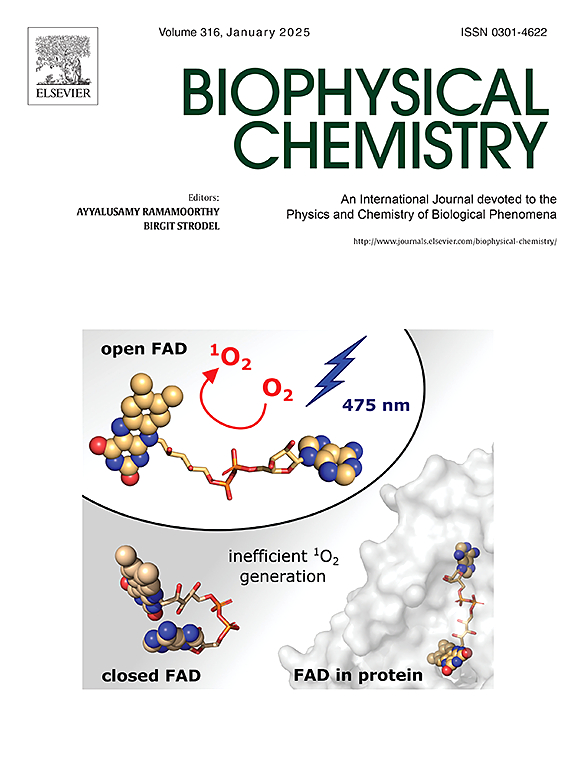受体调节的β淀粉样蛋白聚集体在不对称神经元模型生物膜上的组装和药物诱导的拆卸
IF 2.2
3区 生物学
Q2 BIOCHEMISTRY & MOLECULAR BIOLOGY
引用次数: 0
摘要
淀粉样肽非纤维低聚物引起神经毒性,并可能有助于阿尔茨海默病(AD)的发病机制。越来越多的证据表明,Aβ1-42寡聚物破坏和重塑神经元膜,导致神经元细胞死亡。由于神经元细胞膜的复杂性,单个神经元膜成分参与实时Aβ1-42聚集体的组装尚不清楚。利用非法拉第电化学阻抗谱(EIS)实时跟踪了含有阴离子磷脂和鞘糖脂的不对称微孔悬浮脂质双层膜中单体Aβ1-42肽的结合和聚集途径。阴离子DOPC:PIP2孔悬浮膜在2小时内形成孔,但在6小时内发生肽插入,肽在膜表面聚集的开始时间为~ 6 - 8小时。在不同的神经节苷类中,肽与含GM1-和含gm3的膜结合不导致孔发育,但受体介导的肽聚集形成导致膜导纳在2小时内降低。相反,部分肽在膜表面的插入增加了GD1a和混合GSL膜的膜导纳,阻止了聚集。非对称固体支撑脂质双分子层(aSLBs)的延时AFM成像证实了EIS的发现,捕获了孔隙形成和受体介导的肽组装途径。aSLBs的荧光寿命成像(FLIM)和空间分辨单点荧光相关光谱(FCS)揭示了膜-肽的相互作用、组装和肽诱导的膜重组。抗抑郁药氟西汀和丙咪嗪治疗协同作用,具有成本效益,能够穿过中枢神经系统(CNS+),导致膜介导的Aβ1-42聚集体的分解,但不破坏原纤维。总的来说,这些数据表明,在AD进展的正确时间,膜介导的聚集体分解可以通过使用重新定位的药物来停止或逆转淀粉样蛋白的组装。本文章由计算机程序翻译,如有差异,请以英文原文为准。

Receptor modulated assembly and drug induced disassembly of amyloid beta aggregates at asymmetric neuronal model biomembranes
Amyloid peptide non-fibrillar oligomers cause neurotoxicity and may contribute to Alzheimer's disease (AD) pathogenesis. Mounting evidence indicates that Aβ1–42 oligomers disrupt and remodel neuronal membrane, causing neuronal cell death. The involvement of individual neuronal membrane constituents in real-time Aβ1–42 aggregate assembly is unclear due to complexity of neuronal cell membrane. We used non-Faradaic electrochemical impedance spectroscopy (EIS) to track monomeric Aβ1–42 peptide binding and aggregation pathways in real-time in asymmetric micropore suspended lipid bilayer membranes with anionic phospholipids and glycosphingolipids. Anionic DOPC:PIP2 pore suspended membrane showed pore-formation within 2 h of incubation, but peptide insertion occurred over 6 h, with an onset time of ∼6–8 h for peptide aggregation at the membrane surface. Among different gangliosides, peptide binding to GM1- and GM3-containing membranes did not result pore development, but receptor mediated peptide aggregation formation caused membrane admittance to decrease within 2 h. In contrast, partial peptide insertion in the membrane surface increases membrane admittance at GD1a and mixed GSL membranes, arresting aggregation. Time-lapsed AFM imaging at asymmetric solid supported lipid bilayers (aSLBs) corroborated EIS findings, capturing pore-formation and receptor mediated peptide assembly routes. Fluorescence lifetime imaging (FLIM) imaging and spatial resolved single-point fluorescence correlation spectroscopy (FCS) at aSLBs revealed membrane-peptide interaction, assembly, and peptide induced membrane reorganization. Treatment with antidepressants fluoxetine and imipramine therapeutics, in synergy, which are cost-effective and capable of crossing the central nervous system (CNS+), resulted in the disassembly of membrane mediated Aβ1–42 aggregates, but not fibrils. Overall, the data suggests that membrane-mediated aggregate disassembly at the correct timing of AD progression may halt or reverse amyloid assembly through the use of repurposed drugs.
求助全文
通过发布文献求助,成功后即可免费获取论文全文。
去求助
来源期刊

Biophysical chemistry
生物-生化与分子生物学
CiteScore
6.10
自引率
10.50%
发文量
121
审稿时长
20 days
期刊介绍:
Biophysical Chemistry publishes original work and reviews in the areas of chemistry and physics directly impacting biological phenomena. Quantitative analysis of the properties of biological macromolecules, biologically active molecules, macromolecular assemblies and cell components in terms of kinetics, thermodynamics, spatio-temporal organization, NMR and X-ray structural biology, as well as single-molecule detection represent a major focus of the journal. Theoretical and computational treatments of biomacromolecular systems, macromolecular interactions, regulatory control and systems biology are also of interest to the journal.
 求助内容:
求助内容: 应助结果提醒方式:
应助结果提醒方式:


